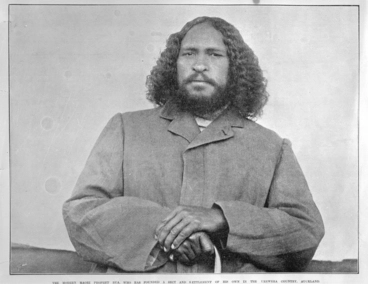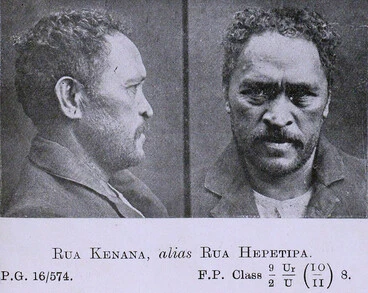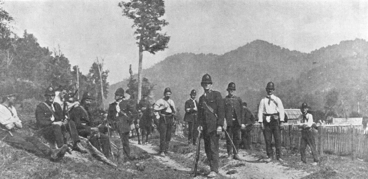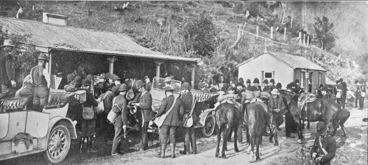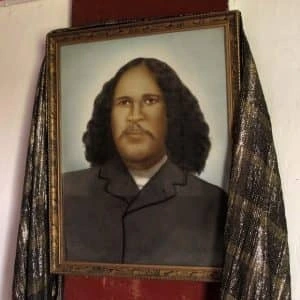The arrest of Rua Kēnana
A DigitalNZ Story by Janice
A set of images and articles covering the invasion of Maungapōhatu and the arrest of Tūhoe prophet Rua Kēnana.
Whakatauki
Na Toi raua ko Pōtiki te whenua Na Tūhoe te mana me te rangātiratanga
The land comes from Toi and Pōtiki The power and prestige comes from Tūhoe
Half length portrait of Rua the prophet...
Auckland Libraries
Rua Kēnana - The Ngāi Tūhoe prophet and successor to Te Kooti
Rua Kēnana, of Ngāi Tūhoe, was born in 1868 or 1869. When Te Kooti died in 1893 he claimed to be the successor named Hepetipa (Hephzibah) whom Te Kooti had prophesied would complete his work by regaining the land.
His claims divided the Ringatū Church founded by Te Kooti. Many Tūhoe saw Rua as a symbol of a new era in which their lost lands would be returned and kept in their name. In 1907 he built a new religious community at the foot of Maungapōhatu, the mountain sacred to Tūhoe.
Source: 'Rua Kēnana', URL: https://nzhistory.govt.nz/people/rua-kenana, (Ministry for Culture and Heritage), updated 8-Nov-2017
Rua Kēnana, alias Rua Hepetipa : 1916 Police Gazette
Archives New Zealand Te Rua Mahara o te Kāwanatanga
Rua Kēnana arrested - 2 April 1916
By 1907 prophet and community leader Rua Kēnana had attracted a following of 600 people. Many Pākehā saw the avowedly autonomous kāinga as subversive.
On Sunday 2 April 1916, 57 police raided the Ngāi Tūhoe settlement of Maungapōhatu in the Urewera Ranges
Source: 'Arrest of Rua Kēnana', URL: https://nzhistory.govt.nz/arrest-of-rua-kenana, (Ministry for Culture and Heritage), updated 9-Dec-2016
Reasons for the arrest of Rua Kēnana
Māori politicians like Māui Pōmare and Āpirana Ngata believed that traditional tohunga (spiritual leaders) such as Rua inhibited Māori progress.
In 1915 Rua was charged with illicitly selling alcohol.
Concerned about his opposition to Tūhoe men enlisting for military service, the government seized this opportunity to punish him.
After Rua failed to appear before a magistrate when summonsed in January 1916, Police Commissioner John Cullen instigated an armed police expedition to Maungapōhatu.
Source: Arrest of Rua Kēnana', URL: https://nzhistory.govt.nz/arrest-of-rua-kenana, (Ministry for Culture and Heritage), updated 9-Dec-2016
Rua charged
Article on Rua supplying liquor and assuming the title of 'Kaiser'.
National Library of New Zealand
Rua accused of tohungaism
National Library of New Zealand
Rua's charges
Article on Rua supplying and selling liquor without a licence.
National Library of New Zealand
RUA THE SLY-GROG SELLER. (Poverty Bay Herald, 30 March 1916)
National Library of New Zealand
John Cullen who led the arrest of Rua Kēnana
In early 1916 the government decided to suppress the activities of the prophet Rua Kenana, who was challenging the authority of the state and encouraging Maori to refuse to participate in the war effort. Cullen headed an expedition of several dozen policemen to Maungapohatu, Rua's capital deep in rugged bush territory in the Urewera.
Source: Richard S. Hill. 'Cullen, John', Dictionary of New Zealand Biography, first published in 1996. Te Ara - the Encyclopedia of New Zealand, https://teara.govt.nz/en/biographies/3c42/cullen-john (accessed 2 February 2020)
Bad cop: the story of John Cullen
Radio New Zealand
Police on their way to arrest Rua
Police approaching Maungapohatu, to arrest Rua Kenana
Alexander Turnbull Library
A group of police sitting and standing on...
Auckland Libraries
Showing groups of police being issued with...
Auckland Libraries
Police party before raid on Maungapohatu
Alexander Turnbull Library
Police alongside Rua Kenana Hepetipa's wooden circular courthouse and meeting house at Maungapohatu
Alexander Turnbull Library
The scene of the arrest
Rua was arrested at Maungapohatu by an armed force of 57 constables sent secretly from Auckland and two smaller contingents from Gisborne and Whakatane. He was seized on the marae, where he was standing unarmed, accompanied by Whatu and Toko, waiting to greet the police.
Source: Judith Binney. 'Rua Kenana Hepetipa', Dictionary of New Zealand Biography, first published in 1996. Te Ara - the Encyclopedia of New Zealand, https://teara.govt.nz/en/biographies/3r32/rua-kenana-hepetipa (accessed 1 February 2020)
RUA ARRESTED. (Taranaki Daily News 4-4-1916)
National Library of New Zealand
Showing women and children sitting...
Auckland Libraries
RUA CAPTURED. (Northern Advocate, 04 April 1916)
National Library of New Zealand
THE RUA CASE. (Colonist, 01 May 1916)
National Library of New Zealand
Who fired the first shot?
At the same moment, a shot was fired. In the ensuing mêlée two Maori were killed, one of whom was Toko. The senior police officers later orchestrated the police evidence, stating that the first shot was fired by a Maori and was part of a planned ambush; the Maori stated it was a police shot.
Source: Judith Binney. 'Rua Kenana Hepetipa', Dictionary of New Zealand Biography, first published in 1996. Te Ara - the Encyclopedia of New Zealand, https://teara.govt.nz/en/biographies/3r32/rua-kenana-hepetipa (accessed 1 February 2020)
The historian Judith Binney stated that the police later manipulated the evidence to make it appear that Māori, planning an ambush, had fired first. Binney concluded that the ‘weight of evidence’ supported Rua and his followers’ denial of this version of events; in fact, one of the Māori who died might have been shot in cold blood. The way in which the arrest warrant was executed was later found to be highly questionable, if not illegal.
Source: Rua Kēnana', URL: https://nzhistory.govt.nz/people/rua-kenana, (Ministry for Culture and Heritage), updated 8-Nov-2017.
Tuhoe's Bloody Sunday | E-Tangata
E-Tangata
Inspector Sheehan swears to have not fired a shot.
THE RUA TRIAL. (Wanganui Chronicle, 20 July 1916)
National Library of New Zealand
RUA'S MANA BROKEN. (Colonist, 05 April 1916)
National Library of New Zealand
ALLEGED PERJURY (Otago Daily Times 6-12-1916)
National Library of New Zealand
The trial of Rua Kēnana
The Auckland Supreme Court heard Rua’s case in October 1916. He was accused of sedition for speaking against conscription and urging his followers to resist the police. The jury couldn’t reach a verdict on the charge of resisting the police; some observers claimed that the police action had been both illegal and excessive. The jury rejected the sedition charge and noted that he was only ‘morally’ guilty of resisting his initial arrest in 1915.
The judge nevertheless sentenced Rua to one year’s imprisonment with hard labour and another 18 months of ‘reformative detention’, a sentence so harsh that eight members of the jury protested publicly and petitioned Parliament about it. Rua remained in prison until April 1918.
Source: 'Rua Kēnana, resisting police', URL: https://nzhistory.govt.nz/media/photo/rua-kenana-resisting-police, (Ministry for Culture and Heritage), updated 10-Jul-2018
Rua Kēnana and his lawyer
Explore this set of images and articles on the trial of Rua Kēnana.
DigitalNZ
Rua Kēnana Pardon Bill - more than 100 years later, the crown acknowledges the wrong done
Commemoration marks 100 years since Tuhoe arrest
Radio New Zealand
Emotions run high as Rua Kenana Pardon Bill passed
Radio New Zealand
Rua Kēnana pardon: 200 descendants gather at Parliament
Radio New Zealand
